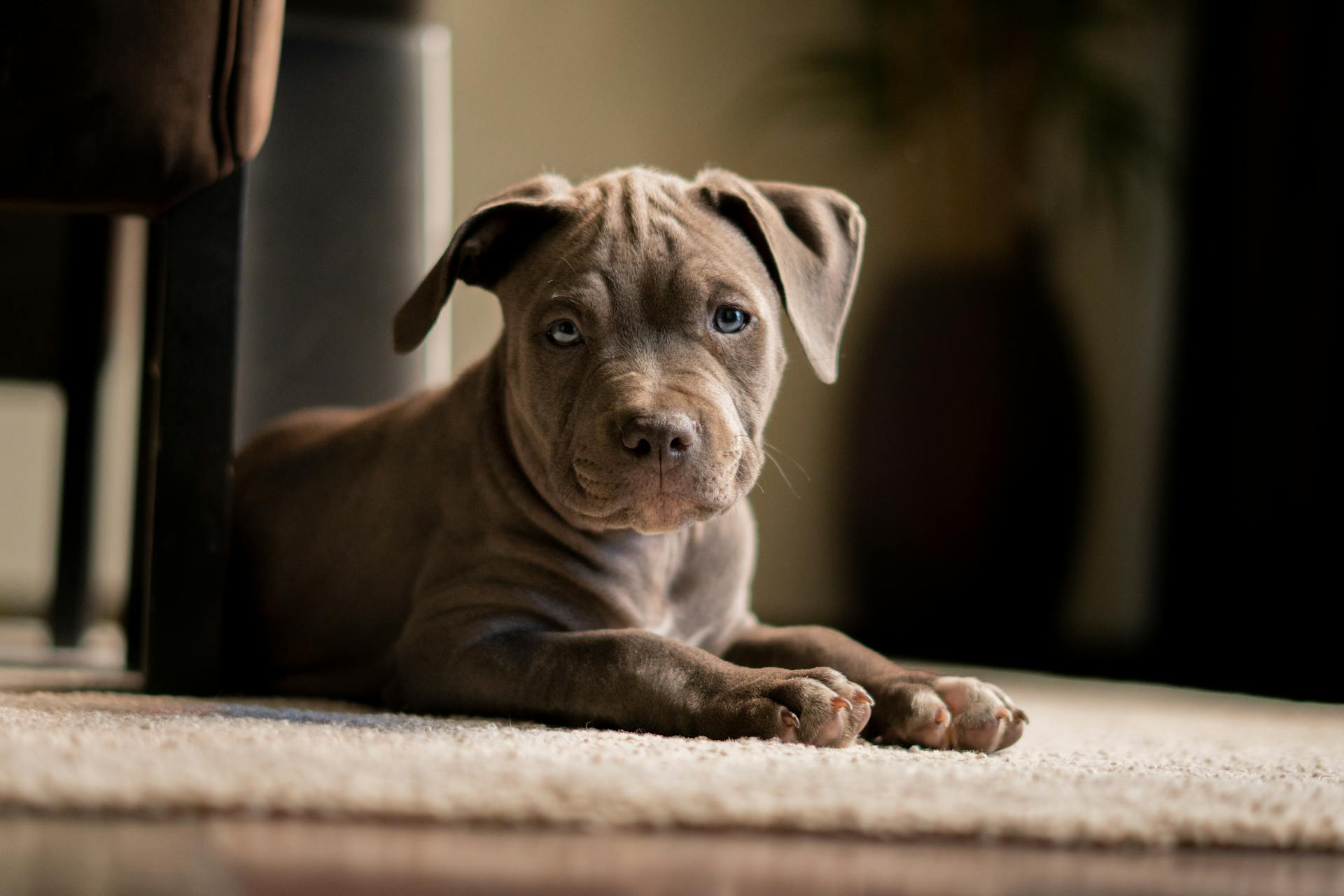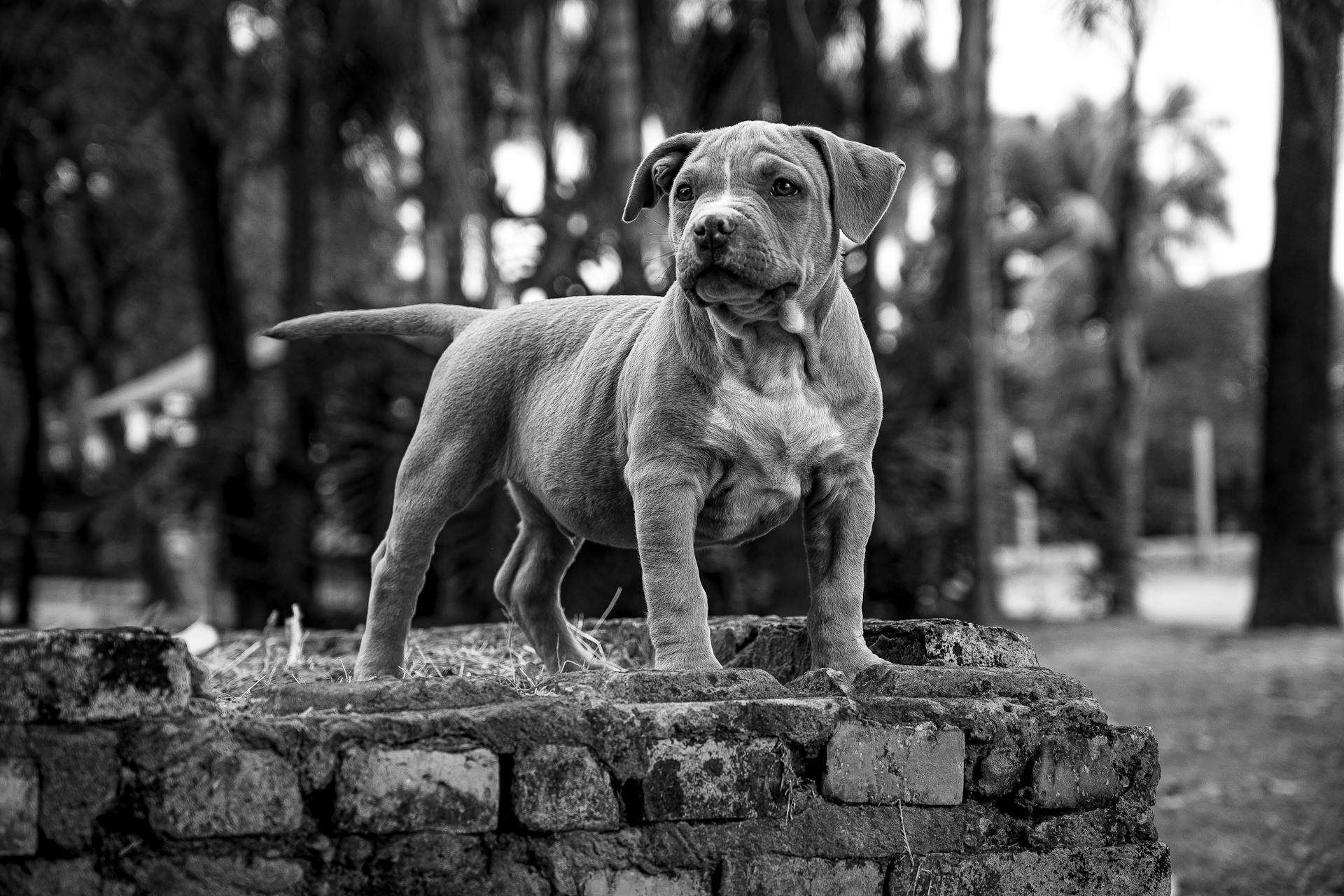Bully Kutta Puppies are a rare and majestic breed, originating from the rugged terrain of Pakistan and India. They are a natural guardian of their families and territories.
To care for a Bully Kutta puppy, it's essential to provide a spacious living area with plenty of room for exercise and play. These dogs can grow up to 30 inches in height and weigh between 80 to 140 pounds.
Bully Kutta puppies require a balanced diet rich in protein and fat to support their growth and development. A high-quality puppy food should be introduced at an early age, with a gradual transition to adult food by 12 months.
Socialization is a crucial aspect of Bully Kutta puppy care, as they can be wary of strangers and may develop aggression if not properly socialized. Early exposure to various environments, people, and situations can help them become confident and calm companions.
You might like: Homemade Food for American Bully Puppy
Origin and History
The Bully Kutta is a rare dog breed that originated in the Indian subcontinent, either in the Thanjavur and Tiruchi districts of Madras or the Sind region of medieval India.
This breed has a long and rich history, with some iterations dating back to the 16th century. The Bully Kutta is also known as the Pakistani Mastiff or Indian Mastiff.
The breed's ancestors include the extinct Alaunt, which originated in the Sindh region of modern-day Pakistan. This strong and dominant Bulldog mix was used for guarding and fighting purposes.
The Bully Kutta was a favorite pet of ruling families in Thanjavur, and even the Mughal emperor Akbar owned one, using it for hunting. The breed's intelligence and loyalty made it a popular choice for nobility.
In the 19th century, the Bully Kutta was showcased at the Second International Dog Show in London, where it impressed audiences with its size and strength. The breed's popularity has endured, with many people today keeping them as family pets.
Despite their gentle nature when properly trained, Bully Kuttas are naturally protective and distrustful of strangers. They require an experienced owner who can provide firm training and instruction to manage their large size and dominant nature.
The breed's origins are still debated, with some claiming it to be from India and others from Pakistan. However, one thing is certain – the Bully Kutta is a rare and special breed that deserves our respect and care.
Explore further: Dogs Breeds That Start with B
Breed Characteristics
The Bully Kutta is a large dog breed with a muscular structure, thick bones, and a broad head. They have a short coat that's predominantly white, but can also come in black, brown, brindle, and piebald colors.
Their eyes are almond-shaped, and their ears are erect but often cropped. The tail is long and tapering to a fine point. They have loose skin around the neck and jaw, similar to Bulldogs.
Here are the key characteristics of the Bully Kutta breed:
Characteristics
The Bully Kutta is a large dog breed, characterized by its muscular structure and broad head. They have a sturdy build, with long and lean legs despite their large bodies.
Their coat is short and straight, with a predominantly white coloration. However, other colors like black, brown, brindle, and piebald are also common.
Bully Kuttas have almond-shaped eyes and erect ears, although the ears are often cropped. Their tail tapers to a fine point, adding to their overall athletic appearance.
Their loose skin, especially around the neck and jaw, is a distinctive feature of the breed.
What Size?
The bully kutta is considered a large dog, and they will typically weigh between 130 and 170 pounds.
They will stand between 28 and 44 inches tall. Female bully kuttas are generally smaller and weigh less than males of this breed.
Consider reading: Will a Great Pyrenees Attack an Intruder
Types/Variations
The Bully Kutta is a highly versatile breed, and its variations are a testament to its adaptability. One of the most striking features of this breed is its ability to thrive in different environments.
The breed was originally divided into many kingdoms during British rule, resulting in various regional preferences that shaped its characteristics. This diversity is evident in the numerous variations of the Bully Kutta.
Here are some of the most common variations of the Bully Kutta:
- Ancient Type Bully Kutta
- Nagi Bully Kutta
- Mastiff Type Bully Kutta
- Aseel Bully Kutta
- Modern Bully Kutta
Pros and Cons
The Bully Kutta is a wonderful breed, but like any dog, it's not without its pros and cons.
They are intelligent, which makes them relatively easy to train if started early.
As an overall good-natured breed, they get along well with kids and other pets, making them a great addition to many families.
If socialized well, they love people and can be a great companion.
Fairly affordable price is another advantage of owning a Bully Kutta.
These dogs are generally good with kids, but they can be hard to train as adults, so early training is key.
They are naturally very healthy, and generally require less vet care than most other dog breeds.
They are independent and self-learners, and very suitable for living in a tropical climate.
However, they can be dominant if not trained well, and may not be the best fit for apartment living.
Here's a summary of their pros and cons:
Overall, the Bully Kutta is a wonderful breed that can make a great addition to many families, but it's essential to consider their pros and cons before deciding to bring one home.
Temperament and Behavior
Bully kutta puppies are known for being intelligent and noble, with a strong sense of sight and smell that makes them a good guard dog. They are naturally protective of their territory and owners, and will bark to alert their owners of a threat.
Their heavy size and dominance can make them a danger to both owners and strangers, especially if they haven't been properly socialized. They are potentially not good with children and other pets, including dogs.
Bully kuttas have a unique gait similar to that of a lion or tiger, and they are very energetic. They need a huge space to run around and exercise, making them unsuitable for apartment life.
Strong socialization is crucial to control their aggressive behavior, especially in situations where they may feel threatened. It's essential to have an experienced owner who can handle their strong will and independent nature.
Despite their tough exterior, bully kuttas are loyal companions who form strong bonds with their families. They are not lap dogs, but they do enjoy spending time with their owners, whether it's playing outside or resting together.
With proper training and socialization, bully kuttas can be excellent pets or family dogs. However, they do require a lot of care and management to ensure they remain well-adjusted and safe.
Here's an interesting read: How Strong Is a Tibetan Mastiff
Grooming and Health
The bully kutta is a relatively low maintenance breed when it comes to grooming. They have a short coat that sheds minimally, requiring only occasional brushing with a firm-bristled brush to maintain their coat's gloss.
Bathing is not necessary, and a damp towel can be used to remove dirt. It's also essential to trim their nails when they become too long.
As for health, the bully kutta is generally a sturdy breed, but they can be prone to certain issues later in life. These include arthritis, blindness, and bloating, as well as dental and flea issues. Regular veterinary visits can help catch these problems before they become severe.
For your interest: American Foxhound Health Issues
Grooming
The bully kutta's grooming needs are relatively low maintenance. They are an average shedder, which means they shed about as much as most other breeds.
Their short coat doesn't require frequent bathing, but a damp towel can help remove dirt and debris. You can also use a firm-bristled brush to maintain the gloss of their coat.
Brushing is essential to keep their coat in good condition and to help with shedding. They should be brushed every so often, ideally once or twice a week.
Trimming their nails is a must when they get too long. Stripping, which involves removing dead hairs by hand, is also a good option for cleaning them.
Their coat type is straight and short to medium in length, and it's not particularly dense. This makes them a relatively easy breed to groom.
Health Problems
As a dog owner, it's essential to be aware of the potential health issues that can affect your Bully Kutta.
Arthritis is a common condition that can affect Bully Kuttas later in their life, making it essential to monitor their joint health.
Regular veterinary visits are crucial to catch any health problems before they become too serious for your dog.
Bloating is not uncommon in dogs of this size, and it's essential to keep an eye out for signs of this condition.
Take a look at this: Embark Dog Dna Test Breed & Health Kit Stores
Eye problems, including blindness, can also affect Bully Kuttas, so regular eye check-ups are a must.
Skin allergies and hip dysplasia are other health concerns that you should be aware of when owning a Bully Kutta.
Dental and flea issues, as well as halitosis, are also common problems that can affect this breed.
By being aware of these potential health issues, you can take steps to prevent or manage them, ensuring your Bully Kutta lives a happy and healthy life.
Lifespan
The lifespan of a Bully Kutta is a significant factor to consider as a responsible owner. The average lifespan of a Bully Kutta is between 6 and 13 years.
Regular veterinary check-ups can help ensure your Bully Kutta lives a long and healthy life.
Dog Nutrition
Bully Kutta puppies are large and energetic, so they need a diet that's formulated for a large breed with high exercise needs.
You can feed your Bully Kutta puppy either wet or dry food, or a combination of these foods. They'll need to eat between 2 and 4 cups of food per day.
Curious to learn more? Check out: Puppys Food
As they grow, you'll need to adjust their feeding schedule - 4 meals a day for puppies 8-12 weeks old, 3 meals a day for those between 3 and 6 months, 2 meals a day for those between 6 and 12 months, and just 1 meal a day after that.
Top quality dry dog foods mixed with canned food, water or broth are recommended, making up 40% of their diet, with 30% from vegetables and 30% from starch.
You can also serve general nutritious foods like cottage cheese, fruits, vegetables like potato, carrots, broccoli, cooked eggs, pasta, brown rice, brewer's yeast, and even crushed egg shells for extra nutrition.
Make sure to rotate their foods from time to time to keep things interesting and provide a complete and balanced diet. And don't forget to keep their food and water bowls clean!
If this caught your attention, see: Best Time to Breed Dogs
Care and Training
The bully kutta is an intelligent breed, but they can be stubborn at times. They need an experienced owner and trainer to ensure they're well-behaved.
To train a bully kutta, you'll need to be patient and consistent. Regular changes to the training routine will keep them engaged and prevent boredom.
Bully kuttas require a lot of exercise, including long walks, outdoor runs, and playtime in a fenced-in backyard. This will help them stay happy and well-behaved.
Puppy Care
As a new puppy parent, it's essential to create a suitable environment for your Bully Kutta to thrive. Bully kuttas need large homes with both indoor and outdoor space, and a fenced-in backyard where they can run around and play.
They require regular socialization training from an early age to establish a strong bond and prevent behavioral issues. This breed needs a firm but gentle approach to training.
Bully kuttas need daily exercise in the form of long walks, outdoor runs, and playtime. Regular veterinary care and a high-quality diet of wet or dry food will keep your puppy happy and healthy.
Readers also liked: Dog Breeds That Don't Need Grooming
A short, firm-bristled brush is all you need to maintain their coat's shine. They are an average shedder, so grooming is relatively low maintenance.
Remember, patience and consistency are key when training a Bully Kutta. They can get bored with repetitive training, so mix it up with fun and exciting activities to keep them engaged.
Choosing the Right Dog
If you're considering bringing a bully kutta into your home, it's essential to have experience as a dog owner. This rare breed requires proper training and socialization, which can be time-consuming and demanding.
You should also be prepared to devote your time to this independent dog. Bully kuttas can form strong bonds with their owners, but they need consistent attention and care.
Bully kuttas shouldn't be adopted into homes with multiple dogs, as they prefer to be the only pet. This is crucial for their well-being and happiness.
If you have children, it's best to consider a different breed. Bully kuttas are not suitable for families with kids, as they can be protective of their owners and may not tolerate children's behavior.
In homes where a personal protection dog, guard dog, or watchdog is needed, a bully kutta can thrive. Their noble and devoted nature makes them an excellent choice for individuals who require a loyal companion.
Explore further: Are Portuguese Water Dogs Good for First Time Owners
25 Responses

If you're looking to bring a Bully Kutta into your family, you'll want to consider the costs involved. The cost of a Bully Kutta puppy can vary depending on factors such as location and breeder reputation.
Some individuals have mentioned specific prices in their queries, such as Tom Johnson, who mentioned being willing to pay a significant amount for a male Bully Kutta. However, no exact price was specified.
If you're looking for a Bully Kutta in a specific location, you may want to consider reaching out to breeders or owners in that area. For example, Ketan Ghaisa mentioned living in Mumbai, India, and inquiring about the cost and availability of a pure Bully Kutta male.
Here's a list of some of the locations mentioned by individuals seeking a Bully Kutta:
- Mumbai, India (Ketan Ghaisa)
- Chandigarh, India (Pardeep Kumar)
- Tura, Meghalaya, India (Sangma)
- Kazakhstan (Issa)
If you're considering bringing a Bully Kutta into your home, it's essential to research the breed thoroughly and understand their needs and requirements.
Frequently Asked Questions
Is Bully Kutta a good family dog?
While Bully Kuttas can be good with kids, their large size and high energy levels require extra caution to ensure a safe and harmonious family environment.
What is the price of Bully Kutta puppy in India?
The price of a Bully Kutta puppy in India ranges from INR 35,000 to INR 90,000, varying depending on several factors. Prices differ between males and females, with males costing more.
Featured Images: pexels.com


